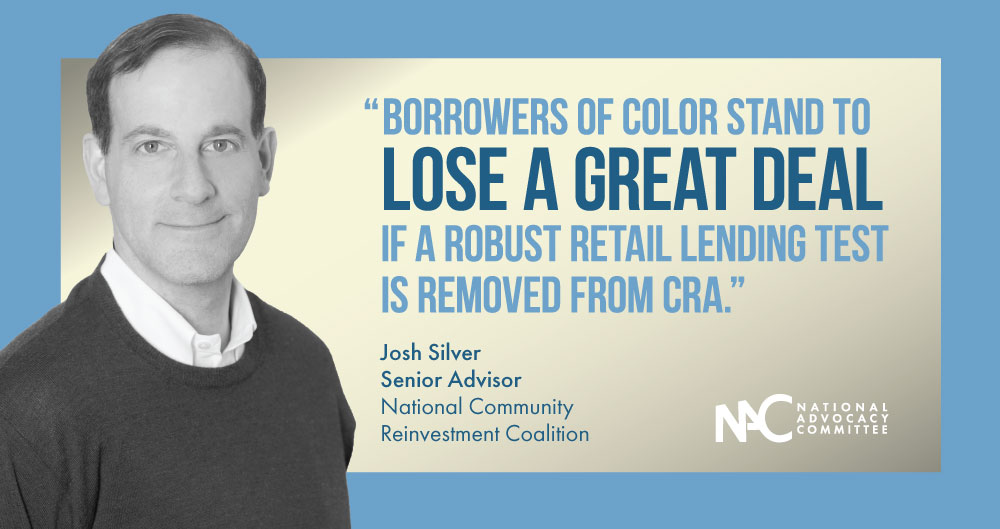Community Reinvestment Act, an interview with Josh Silver from NCRC
Celebrating NAHREP familia, cultura, politics, and grassroots action
Qué onda mi gente?!
¿Cómo andamos? Before we get into this week’s policy discussion, I want to take a moment to recognize a very exciting thing that happened recently. Last week, the U.S. House of Representatives voted to approve the establishment of a National Museum of the American Latino. I had the privilege of working on a bill that explored this possibility back in 2005 with then Congressman Xavier Becerra. It has been a long time coming, and today we are one step closer that museum being a reality.
I have a vision, one where NAHREP’s National Advocacy Committee hosts its reception at this museum. We would celebrate the wins of the year, the legislation we helped pass. On this special night, we could announce Advocacy Chapter of the Year, recognize our top NAHREP advocates and give awards to legislators who have championed our causes. An awards reception followed by some dancing with images of our great heroes in the background, ranging from Ellen Ochoa, the first Latina Astronaut, to Celia Cruz, the Queen of Salsa. I dream of our contributions, our leaders, our music, our food, all being honored as we celebrate the contributions WE are making to shape the future of our country. I’ll see you there familia. It’s going to be epic.

The Community Reinvestment Act is Under Attack
Oftentimes you’ll hear of various “acts” or pieces of legislation that went on to be pivotal to our world, from completely changing the housing industry to significantly impacting our mission to advance sustainable Hispanic homeownership. These include the Fair Housing Act and the Dodd Frank Wall Street Reform and Consumer Protection Act. It also includes the Community Reinvestment Act (CRA) of 1977, a program for which we have to thank for a good portion of the mortgage credit that is extended to low- to moderate-income borrowers today.
Many of the loan officers within the NAHREP familia work under the CRA department of their banks. However, the Comptroller of the Currency (OCC) has introduced changes to CRA that are likely to be detrimental to lending to communities of color. This is why I wanted to invite a good friend, Josh Silver, Senior Advisor at the National Community Reinvestment Coalition (NCRC), and the person who is leading the charge on advocating on behalf of CRA borrowers, to answer some questions as CRA gets a makeover.
Josh, thank you for joining us!
Q: For those who may not be familiar, what is the Community Reinvestment Act or “CRA” and why should our members care about it?
Josh: Congress passed CRA in 1977 in response to redlining or the refusal of banks to lend in modest income neighborhoods and communities of color although they had branches in these communities. Congress imposed an obligation on banks to serve the deposit and credit needs of communities. Periodically, federal regulatory agencies examine banks on their lending, services and investments in low- and moderate-income communities and rate them. The ratings and CRA performance also are important factors for the agencies as they consider whether to approve bank merger applications.
Q: As briefly as you can, can you summarize some of the major proposed changes the Office of the Comptroller of the Currency’s (OCC) new rule is proposing aimed at “strengthening and modernizing” the Community Reinvestment Act (CRA)?
Josh: Three agencies, the Federal Reserve Board (FRB), Federal Deposit Insurance Corporation (FDIC) and the OCC, examine banks for CRA. The FRB and FDIC examine banks with state charters and the OCC examines nationally chartered banks. The OCC implemented their proposed changes to CRA this past May. The OCC’s proposal was so problematic that the other two agencies did not sign onto it. This is unprecedented in the more than 40 years of CRA. The OCC’s new CRA regime is the most harmful I have seen in my 25-year career devoted to CRA and fair lending.
In brief, CRA exams now conduct separate evaluations of bank lending, investment and services. The OCC proposal would fundamentally change the exam structure. A retail lending test would remain but it would be only pass/fail instead of graded. The core of the OCC new evaluation system is a ratio of the dollar amount of CRA activities divided by deposits. This new ratio would distort bank activities. Banks will now be seeking the largest dollar deals in order to boost the numerator of their ratio. The OCC also will give banks credit for financing “essential infrastructure” projects like bridges, sewers and roads. Under the new OCC system, banks will be more apt to finance the large bridge than the smaller home or small business loan.
Neighborhood advocates pushed for CRA in the 1970’s because banks were not making home or small business loans in redlined neighborhoods. The OCC is now de-emphasizing these loans in favor of the larger projects. A new round of neighborhood disinvestment is likely to plague communities of color just when they need more capital to recover from the COVID-19 pandemic.
More on the OCC changes can be found in a fact sheet and a longer NCRC analysis.
Q: How might these changes restrict access to mortgages for first-time borrowers, particularly borrowers of color?
Josh: Borrowers of color stand to lose a great deal if a robust retail lending test is removed from CRA. Currently, the lending test counts for 50% of the overall rating for large banks and looks at the percent of loans to low- and moderate-income people and communities. It also considers innovative and flexible lending like low down payment loans. The new OCC exams will remove the emphasis on lending responsive to the needs for smaller dollar mortgages and low down payments. Look for declines in home lending and small business lending to borrowers of color if the new system is implemented by the OCC, which regulates the largest banks in the country.
Q: What’s next for CRA? What advice do you have for our members as we look to shape public policy around CRA? What is something they can do right now?
Josh: It is likely that the FRB and FDIC will wait until late fall or early winter after the election to propose any changes to their regulations. The FRB was taking an approach based on objective data analysis that would improve the current system rather than tearing it up and imposing a new system that would not be helpful for communities.
Banks also do not like the OCC approach. One of their major concerns is that the ratio measure would not adjust quickly enough to economic cycles. For example, during a recession, the OCC may use a higher ratio as a threshold for passing than is realistically possible according to the bank trade associations.
Given these dynamics, I hope that a new OCC post-election would revoke the rule and work with the other two agencies on a better approach. In the meantime, I urge your members to express their concerns with the three agencies and members of Congress about the OCC’s new rule.
Using the Congressional Review Act authority, the House just voted to revoke the OCC rule. The Senate will be considering a bill in late summer or early fall. Now is a good time for your members to weigh in with their Senators.
That’s a wrap mi gente. Hope you found this informative as it WILL impact your work. This is specifically why Gary Acosta included “Be Politically Savyy” in the NAHREP 10. Because policy impacts our work directly and it’s important to stay informed and active in the discourse.
Un abrazo!

About Noerena Limón
Noerena Limón is NAHREP’s Executive Vice President of Public Policy and Industry Relations. Noerena heads the organization’s policy and advocacy efforts on issues ranging from homeownership, housing inventory, credit access and immigration.
Prior to joining NAHREP, Noerena spent six years at the Consumer Financial Protection Bureau (CFPB) and served as a political appointee under President Obama in the White House Office of Political Affairs.



